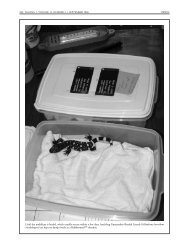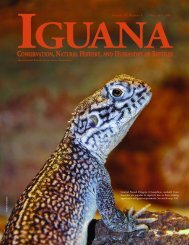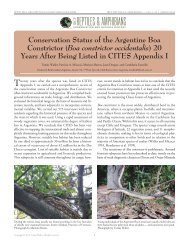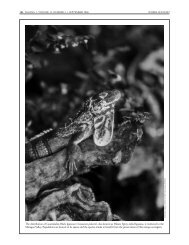Spiny-tailed Iguanas (Ctenosaura similis) in Venezuela
Spiny-tailed Iguanas (Ctenosaura similis) in Venezuela
Spiny-tailed Iguanas (Ctenosaura similis) in Venezuela
Create successful ePaper yourself
Turn your PDF publications into a flip-book with our unique Google optimized e-Paper software.
LAUREN A. WHITE<br />
140 IGUANA • VOLUME 15, NUMBER 3 • SEPTEMBER 2008 DANIELLS ET AL.<br />
to grayish-brown to dark brown with 23–35 rectangular or irregular<br />
dark dorsal saddles. The pattern appears to be washed-out<br />
on much of the body, but becomes <strong>in</strong>creas<strong>in</strong>gly dist<strong>in</strong>ct near the<br />
tail. Like other members of the family Boidae, B. nebulosa gives<br />
birth to live young. The diet consists of small vertebrates such as<br />
agoutis, iguanas, and chickens. Adults have few natural predators,<br />
but humans hunt them for medic<strong>in</strong>al oil. The conservation<br />
status of the species is unknown, but all boids are <strong>in</strong>cluded <strong>in</strong><br />
CITES Appendix II.<br />
Alsophis antillensis (Schlegel 1837). Squamata: Colubridae. Local<br />
names: Kouwès Nwè, Koulèv. English common name:<br />
Dom<strong>in</strong>ican Racer. Lesser Antillean endemic; the subspecies A.<br />
a. sibonius is a Dom<strong>in</strong>ican endemic (other subspecies occur on<br />
neighbor<strong>in</strong>g islands). These diurnal snakes (maximum female<br />
and male SVL 905 mm) occur <strong>in</strong> ra<strong>in</strong> forest, ra<strong>in</strong> forest edges,<br />
coastal scrub, mounta<strong>in</strong> pastures, mangrove edges, deciduous<br />
forests, and orchards/plantations. Adult coloration is dark taupe<br />
through milk chocolate to very dark brown, dark slate gray, and<br />
jet black with white, cream, or light brown blotches. Juveniles<br />
have a dist<strong>in</strong>ct pattern that becomes obscured with age as a result<br />
of <strong>in</strong>creased pigment deposition. These snakes are predom<strong>in</strong>antly<br />
diurnal, with activity peaks at mid-morn<strong>in</strong>g and late<br />
afternoon. Species of Alsophis feed primarily on lizards (especially<br />
anoles), but may consume a variety of terrestrial vertebrates such<br />
as frogs, birds, rodents, and sometimes other snakes. They use a<br />
comb<strong>in</strong>ation of active forag<strong>in</strong>g and ambush forag<strong>in</strong>g strategies,<br />
and may extend activity <strong>in</strong>to the night to hunt anoles eat<strong>in</strong>g<br />
<strong>in</strong>sects attracted to artificial lights. Their conservation status has<br />
not been assessed.<br />
Dom<strong>in</strong>ican Racers (Alsophis antillensis sibonius) are predom<strong>in</strong>antly<br />
diurnal, with activity peaks at mid-morn<strong>in</strong>g and late afternoon, but<br />
they may extend activity through midday on cloudy or ra<strong>in</strong>y days.<br />
Liophis juliae (Cope 1879). Squamata: Colubridae. Local names:<br />
Kouwès jenga, Kouwès zenga, Grove Snake. English common<br />
names: Dom<strong>in</strong>ican Ground Snake, Leeward Ground Snake.<br />
Lesser Antillean endemic; the subspecies L. j. juliae is a<br />
Dom<strong>in</strong>ican endemic (other subspecies occur on Guadeloupe<br />
and Marie-Galante). These diurnally active, ground-dwell<strong>in</strong>g<br />
snakes (SVL to 458 mm) occur <strong>in</strong> ra<strong>in</strong> forest, cut-over hardwoods,<br />
and dry forest. Ground color is typically black with a<br />
“salt and pepper” pattern of white to yellow spots. Communal<br />
nests have been found. These active foragers feed primarily on<br />
small vertebrates, <strong>in</strong>clud<strong>in</strong>g frogs, lizards (especially anoles), and<br />
lizard eggs. Less frequently encountered and presumably less<br />
abundant on Dom<strong>in</strong>ica than Alsophis antillensis, the conservation<br />
status of the species is unknown.<br />
Diurnally active, ground-dwell<strong>in</strong>g Dom<strong>in</strong>ican Ground Snakes (Liophis<br />
juliae juliae) occur <strong>in</strong> ra<strong>in</strong> forest, cut-over hardwoods, and dry forest.<br />
Typhlops dom<strong>in</strong>icanus (Stejneger 1904). Squamata: Typhlopidae.<br />
Local names: Kouwès dé-tèt, Koulèv, Coff<strong>in</strong> Borer. English common<br />
name: Dom<strong>in</strong>ican Bl<strong>in</strong>dsnake. Endemic. These burrow<strong>in</strong>g<br />
snakes (maximum SVL 385 mm) occur <strong>in</strong> well-shaded areas<br />
under rocks and logs, but may be encountered on the surface<br />
after heavy ra<strong>in</strong>s. They have a small, blunt head with scales cover<strong>in</strong>g<br />
the rudimentary eyes and a short tail equipped with a ter-<br />
Dom<strong>in</strong>ican Bl<strong>in</strong>dsnakes (Typhlops dom<strong>in</strong>icanus) are larger than most<br />
of their relatives. All bl<strong>in</strong>dsnakes are burrowers and are rarely encountered<br />
except when heavy ra<strong>in</strong>s br<strong>in</strong>g them to the surface (much like<br />
earthworms). This <strong>in</strong>dividual was found on a trail <strong>in</strong> Cabrits National<br />
Park <strong>in</strong> northwestern Dom<strong>in</strong>ica.<br />
JEFFREY W. ACKLEY<br />
JEFFREY W. ACKLEY








